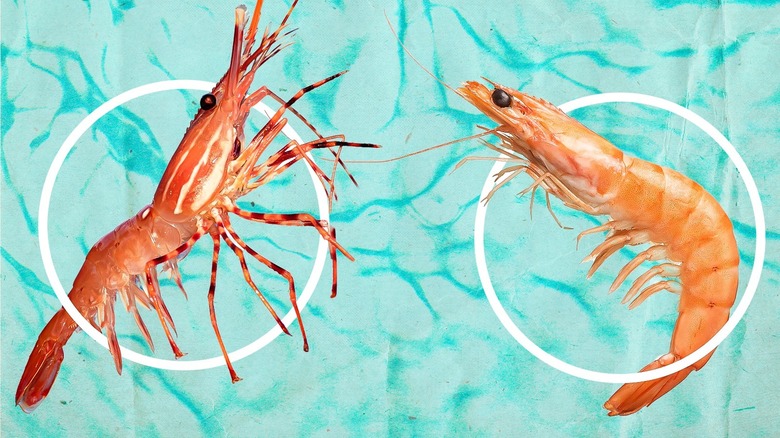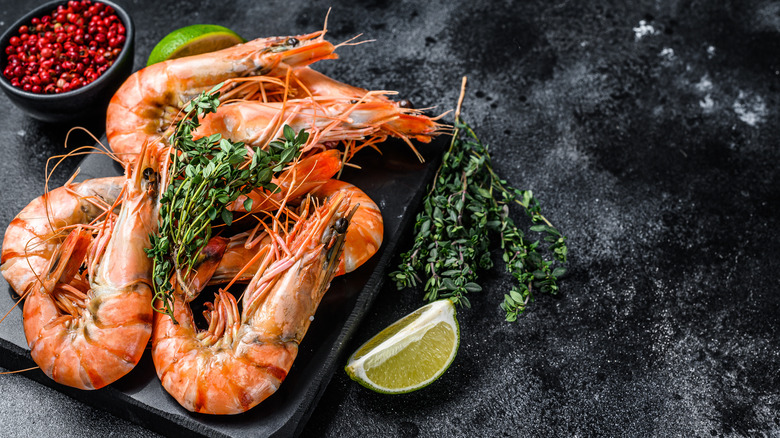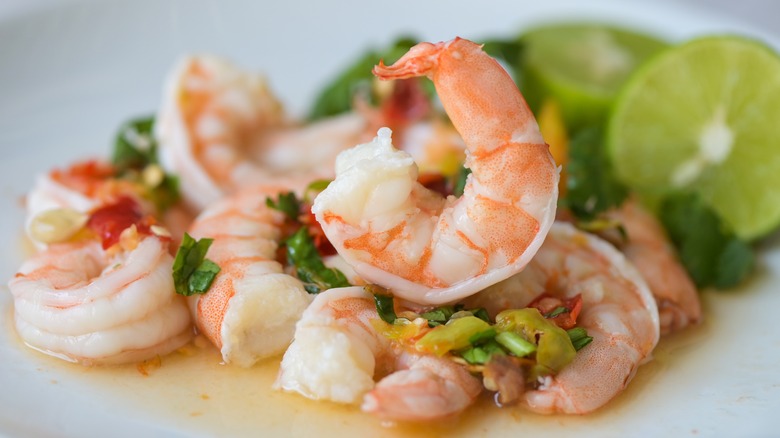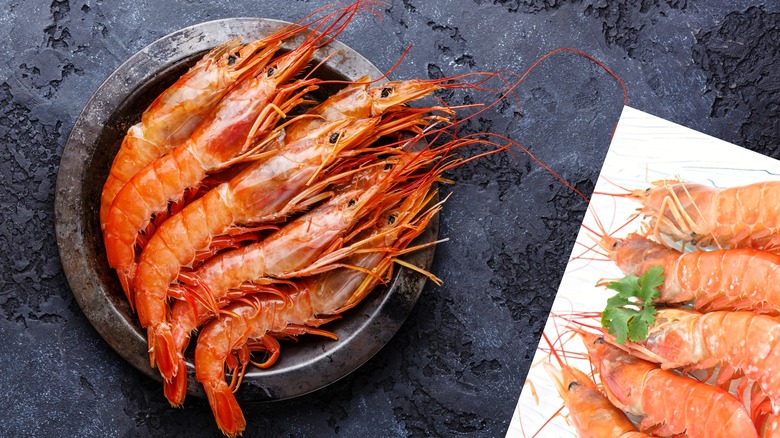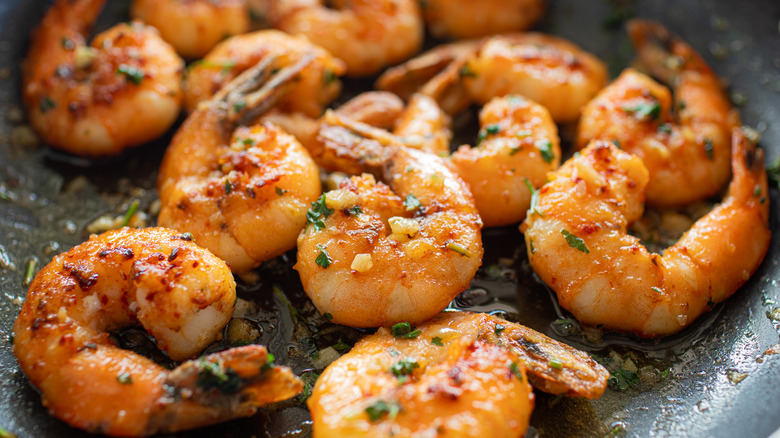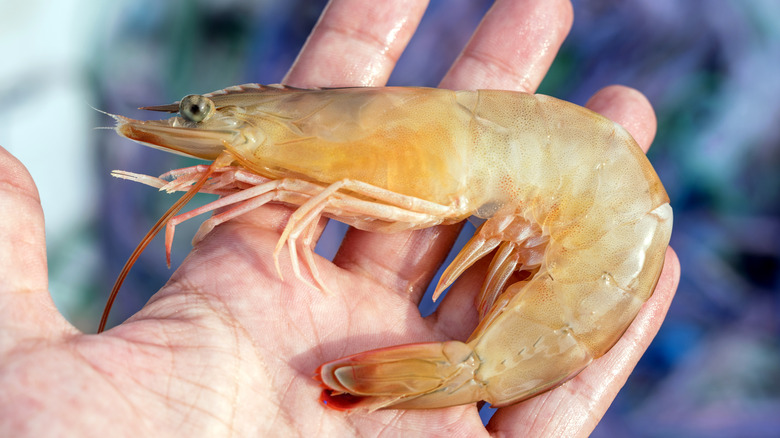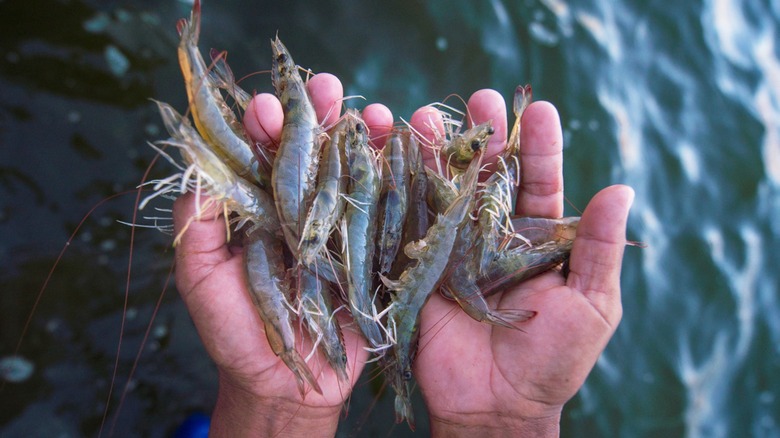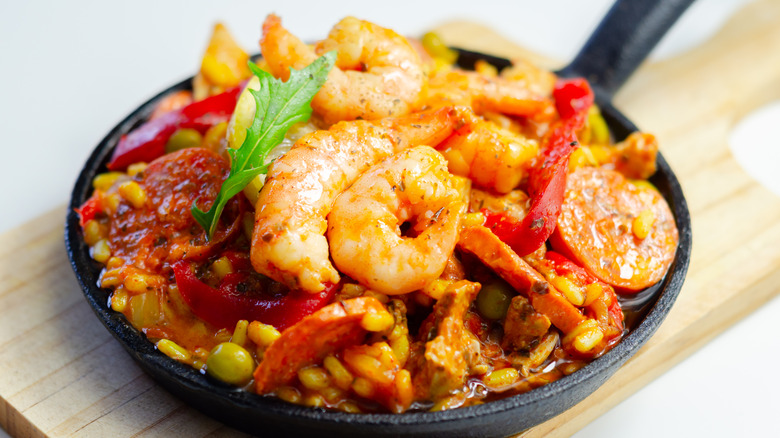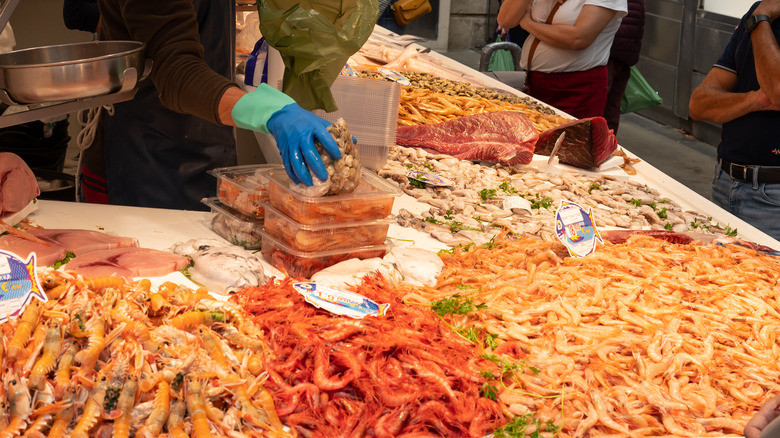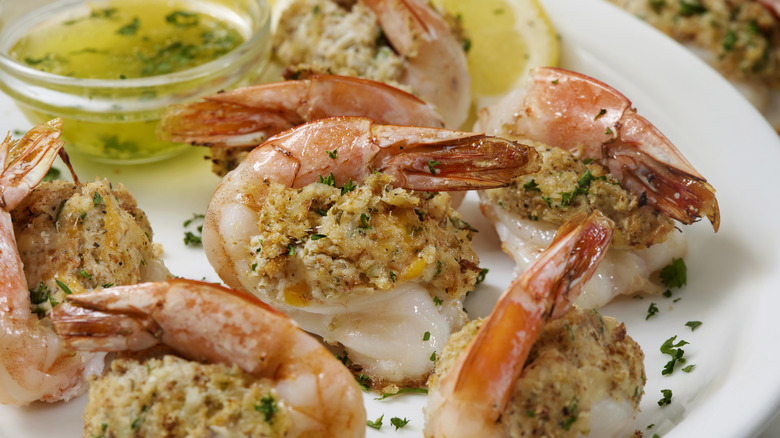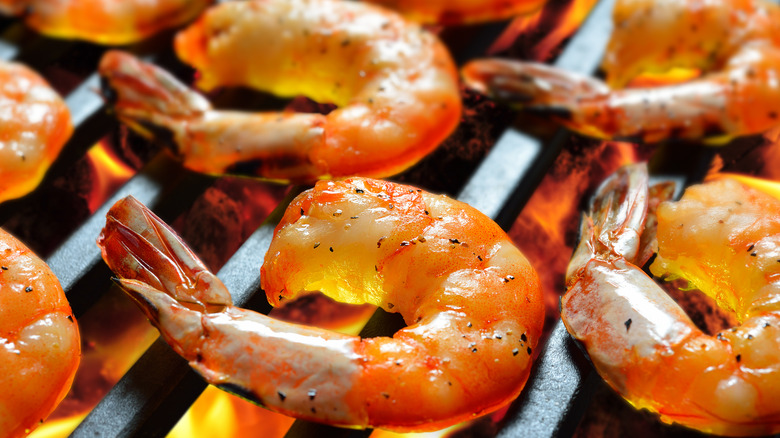Is There A Difference Between Shrimp And Prawns?
From the shores of the Americas to the waters of Asia, prawns and shrimp are some of the most delicious shellfish on the planet. Whether you're a fan of pan-fried coconut shrimp or prawn-filled seafood gumbo, their sweet, mild flavor never seems to get old — just look at how quickly a massive shrimp cocktail spread disappears at your next gathering for proof. According to the National Fisheries Institute, the average American consumes nearly 6 pounds of shrimp yearly.
Still, even the most diehard seafood lovers might draw a blank if asked to spot the difference. After all, isn't prawn just another word for shrimp? Well, not exactly. Contrary to popular belief, prawn and shrimp are two different types of decapods, a type of crustacean with 10 feet. Despite their similarities, they're two separate species. With that said, it's not unusual to see prawns labeled as shrimp on a menu or vice versa.
Once you learn more about them, you can improve your cooking prowess and impress dinner companions. We'll show you everything you need to know about prawns and shrimp, from their defining characteristics to the best ways to prepare them.
The prawn versus shrimp name debate
What's in a name? A lot when it comes to cantankerous crustacean discussions. Distinguishing between a shrimp and a prawn begins with a nod to regional terms and local associations. Consumers in the United Kingdom, Ireland, and Australia use an all-encompassing category in which both sea creatures are one and the same, while North Americans typically distinguish shrimps and prawns as separate entities, explains Healthline.
The shrimp/prawns moniker debate isn't just a seafood industry classification, as it also filters into pop culture, notes USA Today. The famous 1984 throw "another shrimp on the barbie" ad campaign by the Australian Tourism Commission, featuring actor Paul Hogan, reportedly made concessions to North American consumers on the issue. They tossed aside the usual Australian word "prawns" in deference to "shrimp" in order to reach a broader audience.
Which verbiage is correct comes down to science and marine life "families" in the end. Shrimp and prawns do indeed hail from the same crustacean clan known as decapods, but they branch off by suborders: Pleocyemata for shrimps and Dendrobranchiata for prawns. That's where the differences emerge, ranging from appearance to reproduction, habitats, size, and taste. Scientific classifications aside, the lines still get blurred when purchasing them in your local grocery store or seafood purveyor.
What are shrimp?
We batter and fry them, throw them on the grill, and sometimes toss them into pasta — but what exactly are shrimp? First and foremost, shrimp are shellfish, meaning these lovable crustaceans are distantly related to crab and lobster. According to the Global Seafood Alliance, farmers have harvested shrimp for centuries and, today, prawn and shrimp farming is a lucrative business that spans the globe. From the iconic shrimp-filled monologue in "Forrest Gump" to their role in John Wayne Gacy's last meal, it's fair to say that many seafood fans have a soft spot for these hard-shelled creatures.
There are over 3,500 types of shrimp species on Earth, ranging in size from small to "super colossal." Most shrimp in the United States are frozen, often imported from China or Southeast Asia. If you're lucky enough to live near the Gulf Coast, you can find freshly harvested shrimp at local seafood markets. Raw shrimp is excellent for ceviche, while pre-cooked shrimp is best for salad. Salted shrimp, or saeujeot, is also an important ingredient in some types of kimchi recipes. You can also use dried shrimp or shrimp paste to boost the flavors of stocks, sauces, and stews.
What are prawns?
Prawns are among the most popular proteins in certain areas of the world, such as the Southern United States and Asia. Yet, in many instances, the terms "shrimp" and "prawns" are used interchangeably on menus and food labels — which can be confusing and misleading. The usage of "prawn" as an all-encompassing term for both prawn and shrimp is especially prevalent in the United Kingdom, Australia, and New Zealand.
Prawns may share several traits with their shrimpy mates, but they're a different species entirely. While both creatures are decapods, prawns have a few characteristics that set them apart from shrimp. At first glance, it's easy to confuse a prawn for shrimp, as each type of shellfish has a hard exoskeleton and a similar silhouette. However, prawns are distinctive because of their straight, rigid backs, whereas shrimp appear more flexible and rounded. Prawns can be larger than shrimp, with some of the largest specimens reaching lengths of up to 33 centimeters. You can prepare prawns by frying, sautéing, simmering, or grilling them, just as you would with shrimp.
Where they live and how they taste
Most living things at least partially become a product of their environment and our 10-legged crustacean friends are no different. Though shrimp and prawns "can" live in both salt and fresh waters, they overwhelmingly cluster in separate water kingdoms. Most prawns thrive in fresh water, while at least 75% of shrimp make their homes in saltwater domains, according to Healthline.
While taste is very similar between the two, some people point to subtle differences. USA Today notes that distinct habitats include different food chains, potentially affecting taste. When unseasoned, shrimp may appear slightly saltier, and prawns can lean toward a hint of sweetness. This, along with size, may inform your recipes.
Prawns tend to be larger than most shrimp varieties, so pay attention to both weight and the number of shrimp or prawns required in a recipe. When buying either, you'll likely notice a "count per pound" revelation at the store's seafood counter or by the product packager. In general, large shrimp or prawns equate to 40 or fewer included in a pound; Medium sizes will net you roughly 50 and small varieties weigh in at about 60, according to Healthline.
Physical differences between prawns and shrimp
Even with your newfound knowledge of prawns and shrimp, they may still look more or less the same to you. But not to worry — examining their outward appearance is an excellent way to tell the difference between the two decapods. If you ever find yourself in a pickle that involves separating prawns from shrimp, begin by glancing at their spines. Instantly, you'll see that shrimp have a curlier, more curved appearance, whereas prawns have straighter bodies. Moreover, prawns are typically larger than their shrimp brethren.
Although their bodies are often a dead giveaway, there are a few other ways to identify shrimp from prawns. In case you didn't notice, shrimp and prawns have gills to help them take in oxygen underwater. Shrimp gills are layered and look a bit like plates of armor, while prawns have what are known as branching gills. True to their name, prawn gills will visibly expand as they respirate, like fish or axolotl. Lastly, prawns have larger heads and longer antennae, which some refer to as "whiskers."
Look at each crustacean's claws, when in doubt
Still having trouble trying to separate shrimp from prawns? There's one defining feature of both crustaceans that can help guide you in a pinch. That's right — we're talking about their claws or pincers. While they're not quite as impressive or meaty as those belonging to crabs or lobsters, shrimp and prawns have their own sets of claws and legs.
Check out their legs next time you're up close and personal with a prawn. A prawn will have three sets of front legs with adorably tiny claws at the ends of each limb. Prawns also tend to be leggier than shrimp, which makes sense given their larger stature. Conversely, shrimp only have one set of front pincers, making it easy to tell them apart from prawns. Prawns and shrimp use their pincers to grab small fish and other tasty treats, from guppies and algae to plankton. Some prawn species have brightly colored or spotted pincers, which may help them attract vulnerable prey.
Saltwater versus freshwater
Where they live can also tell you a lot about each species, though there are a few exceptions. As mentioned earlier, the biggest international shrimp exporters are Vietnam and Thailand. Most shrimp prefer to dwell in saltwater habitats, where they take on their characteristically briny flavor. Many shrimp live in the Gulf of Mexico and Campeche, burrowing in sand or mud-bottoms.
Prawns, on the other hand, typically stick to freshwater environments, similar to their crayfish cousins. Still, prawns can also thrive in saltwater conditions, though this isn't quite as common.
Shrimp and prawn farming is a well-established practice in Asia, originating centuries ago. According to the Global Seafood Alliance, China, India, and Vietnam are some of the world's top shrimp producers at the time of writing. As a result of the increased popularity of shrimp in the United States, however, several American shrimp farms have begun cropping up in recent years to produce domestic shrimp supplies.
Taste differences between shrimp and prawns may vary
There are numerous varieties of shrimp and prawns, from tiny specimens clocking in at only a few grams to shellfish weighing two or more ounces each. Just as freshly caught oysters possess an array of distinctive flavors, shrimp and prawns can vary wildly in their taste and texture. The numbers on shrimp labels refer to the number of shrimp found in each pound — for instance, small shrimp are marked 51-60 (as in pieces), while jumbo shrimp would be labeled 16-25 (pieces). Baby shrimp, like those used in soups and salads, typically taste milder, while fully developed jumbo or colossal shrimp and prawns develop more complex flavor characteristics.
If you're wondering whether shrimp and prawns taste different from one another, it all depends on who you ask. By most accounts, the two crustaceans are virtually indistinguishable once shelled and plated — but some discerning seafood fans claim they can tell the two decapods apart. Further, depending on how manufacturers process and package shellfish, their taste or tenderness may suffer due to preservatives or brining agents involved. If you're fortunate enough to try freshly caught shrimp or prawns, you can certainly taste the difference in freshness and texture compared to your garden-variety frozen supermarket shrimp.
How to pick the freshest shrimp and prawns
What's the difference between shrimp and prawns that taste good versus those that taste great? How you prepare them certainly plays a part, but choosing fresh shellfish is crucial to achieving the most delicious results. Whether you're looking to serve a sumptuous shrimp cocktail or your favorite chilli prawns recipe, you'll need to know what to shop for when searching for the main ingredient. You might think the plump, chilled, shrimp displayed in your grocer's seafood case is top-tier by looks alone. Yet, most prawns and shrimp are frozen until they reach their final destination at your local supermarket — so if you're looking for the freshest catch, opt for the shellfish stored in the freezer section.
When given the opportunity to select fresh-caught prawns or shrimp at a seafood market, pay close attention to their appearance and texture. First, carefully look them over: The flesh inside their shell should still be somewhat transparent. Any cloudiness or milky coloration can mean they're on the turn. If you can squeeze them, know that fresh prawns or shrimp should have a firm, yet slightly springy, feel. Pass on shellfish that feels soft or squishy, as this is a sure sign that it's past its prime.
Finally, if purchasing pre-cooked shrimp or prawns, avoid those preserved with tripolyphosphate, as this additive can negatively affect their flavor and texture.
Can you substitute shrimp for prawns in recipes?
Let's say you're preparing a dish that calls for prawns, but you only have shrimp on hand. Now what? Before you ditch your menu plan in favor of reservations at Red Lobster, know that you can easily substitute shrimp for prawns. In most cases, flavor and textural differences between the two species are negligible. Therefore, your garlic prawns or shrimp scampi should be largely unaffected if you choose to make a switch.
Still, there are other factors to take into consideration. In terms of taste, prawns or shelled shrimp may not yield enough oomph for stock or sauce recipes, as the structural compound (chitin) found in shrimp shells releases a unique umami flavor. Plus, intact shells are both visually pleasing and useful for appetizers like shrimp cocktail, since their tails make them far easier for dinner guests to grab. Beyond that, jumbo shrimp or prawns are essential to crafting certain dishes, so think twice before attempting to stuff smaller-sized shellfish. Overall, as long as the substitution prawns or shrimp are similar in weight or size to those listed in the recipe, you should be in the clear.
Preparing and cooking prawns and shrimp
Now that you're caught up to speed on your prawn and shrimp facts, it's time to get cooking. Not sure where to start? Just take a look around for inspiration. Tender fried shrimp are fixtures of fish shops, while prawn mayonnaise sandwiches reign supreme on English supermarket shelves. There's also classic seafood paella or Tom Yum Soup — two international dishes that make good use of flavorful shrimp stock.
But no matter how you prefer to eat these delectable decapods, a recipe exists to help you prepare them at home. Of course, it's always helpful to familiarize yourself with the basics before doing so. One of the most common mistakes when making any form of prawn or shrimp is improperly cooking them. Undercooked shellfish can pose health risks, like vibriosis, whereas overcooked shrimp or prawns may taste chewy and rubbery.
To get perfectly cooked prawns and shrimp, only sear them for a few minutes on each side. For perfectly cooked shrimp, it's crucial to take them from heat as soon as they've turned an opaque pink color, as they will keep cooking after you plate them. If adding them to a recipe like shrimp fried rice, set the shellfish aside after cooking and reincorporate them later to preserve their texture. Prawns and shrimp still in the shell are best for soups or grilling, since their shells provide flavor, protect the inner flesh, and seal in juiciness.
